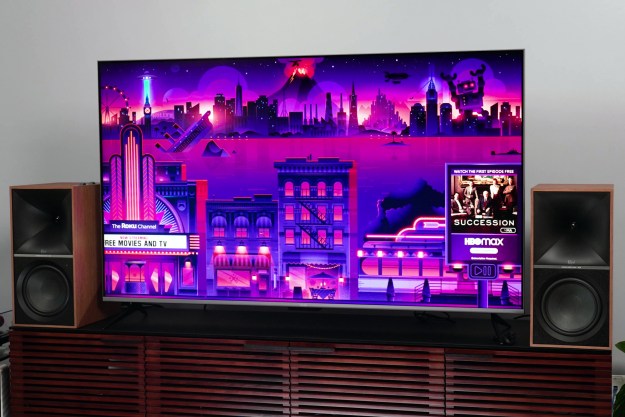Sonos is a well-respected brand in the home and portable audio markets. It is known for it’s range of Wi-Fi-connected speakers, soundbars, amplifiers, and, the topic of this article, subwoofers.
In 2012, Sonos introduced its first subwoofer — the Sonos Sub. Its unique design set it apart from other subwoofers, and since then, two more generations of the Sub have been released. The latest version, Gen 3, has a glossy finish instead of a matte finish like the previous models. While the
That’s where the Sonos Sub Mini comes in. Released in 2022, the smaller Sub Mini offers a cylindrical design and is far more lightweight than its older brother. It’s also quite a bit cheaper, too, at $429. But does it match the Sub when it comes to sound quality? Do I need the big guy, or will the Sub Mini do the trick for my needs?
Let’s compare both the Sonos Sub Mini and the Sonos Sub (3rd Gen), weighing in on key criteria like design, performance, and price, to help you decide which Sonos subwoofer is the one for your home.
Design
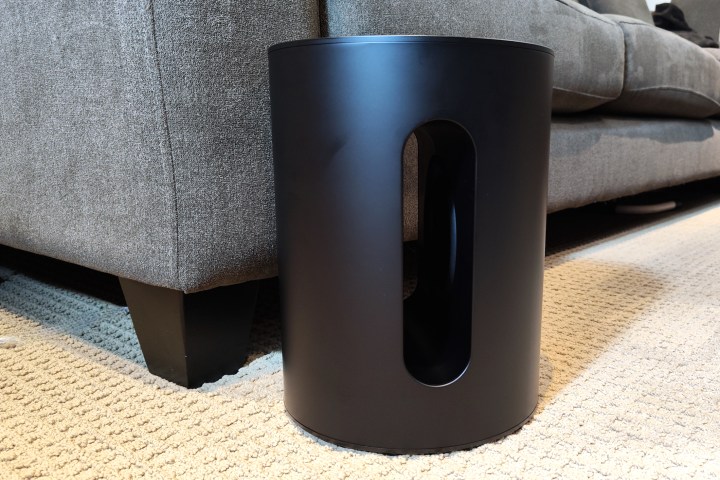
The third-generation version of the Sonos Sub is 15.3 inches wide, 15.8 inches wide, 6.2 inches deep, and weighs 36.3 pounds, and it’s available in glossy white and black finishes, which some owners and reviewers have complained attracts attention to things like greasy fingerprints. That said, there’s really no reason to touch the thing once it’s placed, so this is kind of a non-issue.
Iconic since the Sub’s inception, the Gen 3 model also features a rectangular cutout in the middle of the woofer, which is where the Sub’s inward-facing drivers are located. More than an eye-catching stylistic choice, the cutout is also used to cut down on unwanted cabinet vibrations.
That said, there’s still no getting around the fact that the original Sub model is much bulkier and heavier than the Sub Mini.
Measuring 9.1 inches deep, 12 inches tall, and weighing 14 pounds, the cylindrical Sub Mini is more lightweight, compact, and far easier to relocate than the Sub. We also love the circular perch at the top of the Mini, which can be used to seat lamps and other home necessities that can help the Mini blend with your decor. And for distortion reduction and force cancellation, the Sub Mini also uses the same centralized cutout as the larger model, with the shape of the void replicating the spherical style of the Sub Mini’s outer shell.
The Sub Mini is available in matte white and black finishes, which, unlike the glossy Sub, matches the matte finish of other
Both
As mentioned,
Winner:
Setup and networking
Remember the days of having to install a
And thanks to the inclusion of an
Both the third-gen Sub and Sub Mini are also equipped with wired Ethernet ports, which allow you to plug both Subs into your router for a wired network connection or to use either Sub as an Ethernet bridge for other components if you choose to connect them to Wi-Fi.
Once you add a Sub to your network, using Sonos’ Trueplay feature is recommended. This feature automatically adjusts the
These days, most homes are equipped with dual-band routers that deliver both 2.4GHz and 5GHz networking options, and you’ll be able to use either set of Wi-Fi frequencies for both the traditional third-gen Sub and the Sub Mini. This is especially convenient for earlier
Perhaps the only advantage the
Winner: Tie
Performance
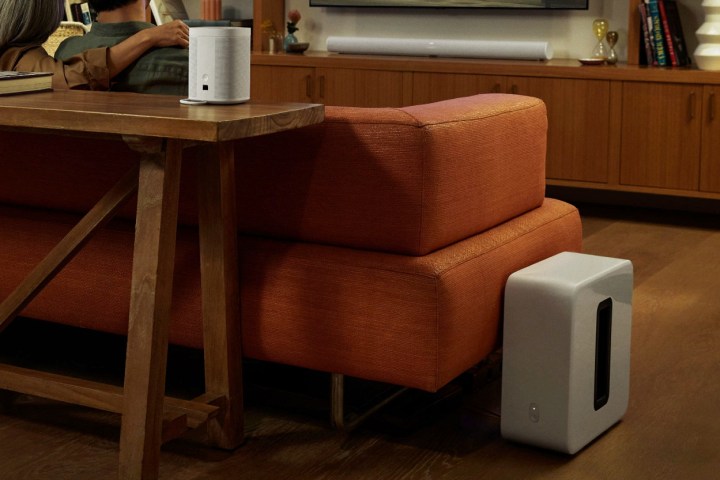
Rating the overall sound quality of both
Right out of the gate, we’ll go on record saying that most folks will adore the type of rumble created by the Sub Mini. With the power of Class-D amplification and two 6-inch woofers that fire against each other, the audible result isn’t going to take the roof off your house, but it will certainly add nuance and presence where it may have been lacking. That’s whether your Sub Mini is linked up for a Sonos surround configuration (i.e., a Sub Mini plus Beam soundbar plus two of the now-discontinued One SLs, or one of the latest Era 100 or Era 300 speakers), Sonos stereo (such as two One, Five or Era speakers linked together), or just one Sonos speaker.
We also love that
But when it’s both precision and power you’re looking for, especially if your home theater is rocking hardware like the Sonos Arc, the larger Sonos Sub may be the better way to go. And while the Gen 3 Sub utilizes the same Class-D power and inward-firing drivers as the Sub Mini, there’s slightly better frequency response overall, more volume, and a squared-off design that makes it easy to tuck underneath furniture like couches and end tables.
While the Sub Mini certainly gets the job done when it comes to bringing the bass, there’s no beating the unbridled boom of the Sono Sub, and that’s disregarding the price factor (we’ll get into that in a minute).
Winner:
Versatility
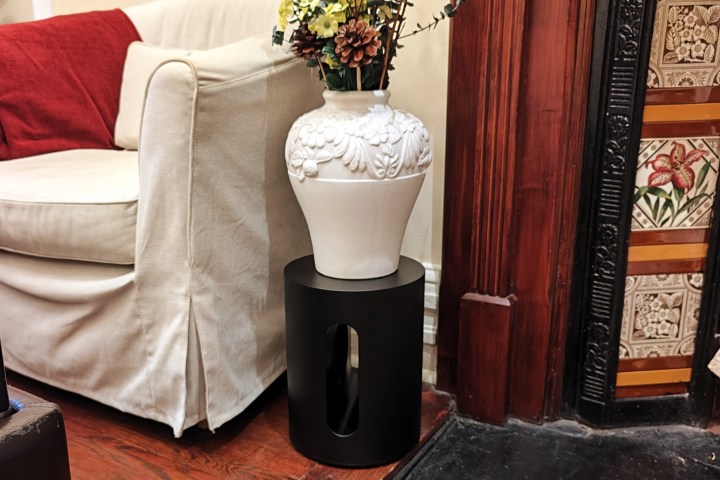
Sonos recommends the larger Sub be used in a medium- or large-sized room, with ideal pairing to the Sonos Arc, Beam, Playbase, or Playbar soundbars, the Sonos Amp, and the Five, Play: Five (Gen 2), or Play:3 speakers. In terms of the Sub Mini, the company recommends the smaller woofer for small to medium-sized rooms, ideally paired up with the Beam, Ray, One, One SL, and Play:1 speakers or the Sonos Amp.
When you consider all the specs, these suggested configurations make a ton of sense. And while most homeowners and apartment dwellers will be more than satisfied with the ample output of a
Yes, you can use the Sub Mini for a simulated
And here’s something else to chew on: As mentioned above, you can only use one Sub Mini at a time. Sure, for most
To that end, we’re awarding a point to the
Winner:
Price and warranty
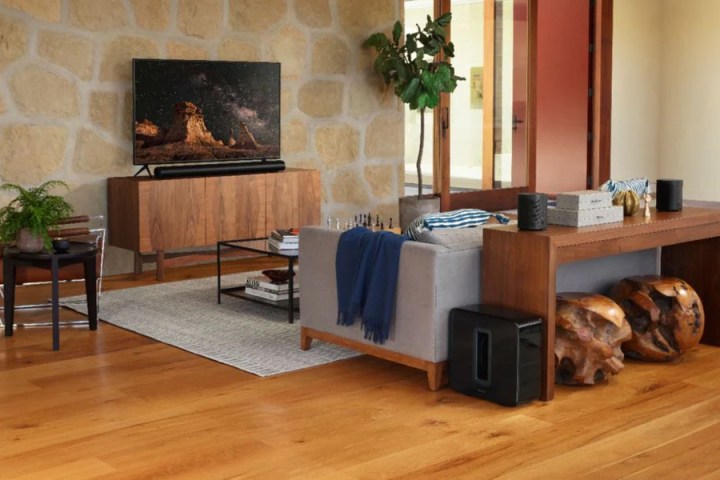
The
The
You can also find both
If we’re speaking purely in terms of affordability, though (and we are), the
Winner:
The bottom line
While we always try to avoid a draw (because there’s always something that leads us to favor one product over another), this is one of those situations where we have to grant this as a stalemate between the
The Sub Mini is perfect for smaller homes, delivers excellent low-end punch, can be used with a number of
Winner: Tie
Editors' Recommendations
- You Asked: tone mapping, bad Blu-ray players, mini-LED vs. microLED, and TCL X955
- Sonos Beam vs. Sonos Ray: Which soundbar is best for you?
- You asked: Should you buy a 70-inch TV, do you really need a Blu-ray player, and more?
- Sony Bravia X95L mini-LED vs. TCL QM8 QLED: The best LCD TV and the one you should buy
- Sonos Atmos vs. Nakamichi Dragon: beauty and the beast

